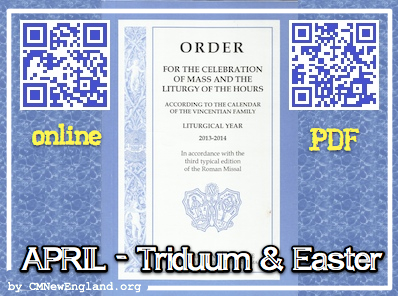 Liturgical norms for celebrations EASTER VIGIL and EASTER DAY according to ORDO – Liturgical calendar for the Vincentian Family.
Liturgical norms for celebrations EASTER VIGIL and EASTER DAY according to ORDO – Liturgical calendar for the Vincentian Family.
The fifty days from Easter Sunday of the Lord’s Resurrection until Pentecost Sunday are celebrated in joy and exultation as one single feastday, as ‘Great Sunday’ (magna dominica). It is on these days in particular that the Alleluia is sung (LY 22).
EASTER SUNDAY OF THE RESURRECTION OF THE LORD,
solemnity with Octave.
Liturgical color: White
EASTER VIGIL
1. By most ancient tradition, this is the night of keeping vigil for the Lord, and the Vigil celebrated during it, commemorating that holy night when the Lord rose from the dead, is regarded as the ‘Mother of all holy vigils’. For in this night the Church awaits in vigil the Resurrection of the Lord, and celebrates it with the sacraments of Christian initiation. The Christian tradition has however always recognized its character of expectation of the Lord’s coming again.
2. The entire celebration of the Easter Vigil must take place during the night, so that it begins after nightfall and ends before daybreak on the Sunday. The practice of celebrating the Easter Vigil on the Saturday evening at the time when the Sunday Vigil Masses are habitually celebrated is to be censured. The whole of the celebration is, moreover, so to be arranged that its nature as a protracted Vigil is safeguarded.
3. The celebration of a Mass without the rites of the Easter Vigil is not allowed.
4. The Easter Vigil may be celebrated even in churches and oratories. Where the liturgies of Maundy Thursday and Good Friday have not taken place, and neither is the Vigil of obligation when they have. The celebration of the Vigil is, however, compulsory where there is a baptismal font.
5. Throughout the whole Vigil liturgy, as also at the Mass, the sacred ministers should wear white vestments.
6. Tonight’s vigil should be so arranged that after the brief Liturgy of Light or lucernarium (which is the first part of the Vigil), the Church meditates on the marvels the Lord God wrought for his people from the very beginning and strengthens by his Word and his promise (the second part of the Vigil, or Liturgy of the Word), until the moment when with the approaching Day of the Resurrection, together with her new members reborn in baptism (third part), the Church is called to the table the Lord has prepared for his people by means of his Death and Resurrection (fourth part).
The whole Easter Vigil proceeds by means of symbols and rites which call for a certain grandeur and dignity, in order that the faithful may grasp their meaning, prompted even by the words of the commentaries, invitations and prayers. It is fitting in particular that the faithful be introduced by means of a brief introduction to the understanding of the typological meaning of the Old Testament readings proclaimed during the Vigil.
7. As regards the blessing of the fire, in so far as possible a large fire should be prepared in a suitable place outside the church, such that its flames may truly scatter the darkness and light up the night.
8. The paschal candle, for effective symbolism, should be made of wax, of one piece, and of a considerable size, and be renewed every year. For it is meant to represent the figure of Christ who as the True Light, illuminates the whole world. The candle should be blessed with the words and gestures laid down by the liturgical books.
9. The Easter Proclamation or Exsultet may be sung, in case of necessity, even by a cantor who is not a deacon, but in this event the cantor does not receive a blessing from the celebrant, and the second part of the invitation is omitted (Quapropter… or Therefore, dearest friends, standing…) as is the greeting Dominus vobiscum (The Lord be with you).
It is possible to sing either the longer or the shorter form.
10. At least three readings are to be proclaimed from the Old Testament, and even in urgent circumstances at least two. The reading from the Book of Exodus is never to be omitted. The series of readings for the Vigil is as follows:
1. Gen 1,1–2,2 (or 1,1,26-31a).
2. Gen 22,1-18 (or 22,1-2. 9a. 10-13. 15-18).
3. Ex 14, 15-15, 1.
4. Is 54,5-14.
5. Is 55,1-11.
6. Bar 3,9-15. 32-4,4.
7. Ez 36,16-17a. 18-28.
3. Rom 6,3-11.
9. Mt 28,1-10.
11. The Baptismal Liturgy of the Easter Vigil reaches its fullest form when the baptism of adults, or at least of children, is celebrated. However, even when the sacrament of Baptism is not celebrated, in parish churches the baptismal water should be blessed. In cases where there are neither baptisms nor blessing of the font, the sacrament of Baptism should be recalled by the blessing of water, with which the faithful are then sprinkled after having renewed their baptismal promises.
12. For the proclamation of the Gospel reading at Mass, incense may be used, but lights are not carried.
13. It is fitting that the fullness of the Eucharistic signs be attained in the Easter Vigil by means of communion under both kinds. It pertains to the local Ordinaries to consider the suitability and the circumstances of such a concession and to lay down appropriate norms.
14. The Mass of the Vigil is the Easter Mass of the Lord’s Resurrection. Any priest celebrating or concelebrating the Vigil Mass in the night may celebrate or concelebrate a second Easter Mass the next morning.
AT THE EASTER VIGILI MASS
proper, with proper Preface and proper inserts of Easter for the Eucharistic Prayer.
ON EASTER DAY:
liturgical color: white
Liturgy of Hours proper of the solemnity. — The Office of Readings is omitted by those who take part in the Easter Vigil.
MASS PROPER OF EASTER DAY, Gloria, sequence, Creed, with proper Preface and proper inserts of Easter for the Eucharistic Prayer.
R1: Ac 10, 34a. 37-43; Ps 117,1-2. l6ab-17. 22-23.
R2: Col 13, 1-4 or 1 Cor 5, 6b-8.
Go: Jn 20,1-9 or Mt 28,1-10.
At an evening Mass the Gospel may be Lk 24, 13-35.
Other celebrations are not permitted, not even funeral Masses.
l. The Mass of Easter Day should be celebrated with great solemnity. At this Mass, in place of the opening penitential rites, all are sprinkled with water blessed on Easter Night, to recall their baptism.
2. The paschal candle, which should be placed near the ambo or near the altar, and kept there for the whole of Easter Time until the end of Pentecost Sunday. It should be lit for the more solemn liturgical celebrations, namely Mass, Lauds, and Vespers, during this time.
3. Where is it still the practice, the custom of celebrating baptismal Vespers on Easter Sunday should be diligently maintained, and where it is not the practice it should whenever possible be introduced. At this celebration of Vespers psalms are sung and there is a procession to the fonts (IH, 213).
Today, and throughout the whole Octave, Sunday Compline (as after either First or Second Vespers), with the antiphon Haec dies, instead of the short responsory.
Instead of the Angelus prayer (The Angel of the Lord…), for the whole Easter season the antiphon Regina coeli (Queen of Heaven rejoice, alleluia…) is recited.
For more information visit this page:
ORDO – Liturgical Calendar of the Vincentian Family
or scan one of the codes in the image

[…] GOOD FRIDAY – Liturgical norms for celebrations » « EASTER VIGIL & EASTER DAY – liturgical norms for celebrations […]